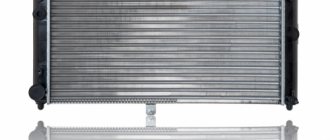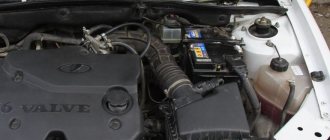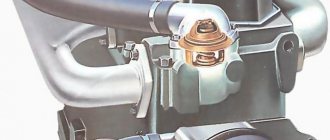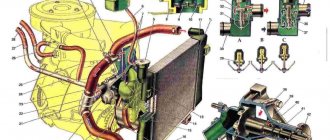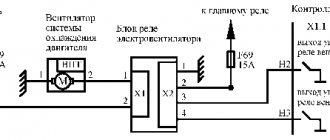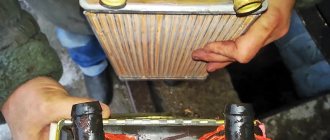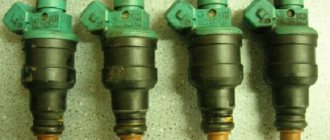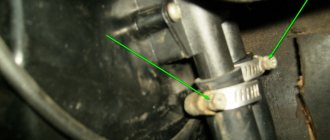Flushing the engine cooling system is an important procedure to prevent engine overheating.
During vehicle operation, the cooling system is subject to a serious load, which can lead to various engine malfunctions. Such engine problems can be prevented by timely and proper radiator maintenance. To do this, it is imperative to regularly flush the cooling system using special auto chemicals, followed by replacing the coolant. In this article we will look at:
- the main causes of clogging of the cooling system,
- how to understand that it’s time to wash,
- how often should you wash?
- what can you wash with?
- How to flush the engine cooling system yourself.
Why do you need to flush the engine cooling system?
The cooling system is an important part of the engine that removes the huge amount of heat generated during engine operation, preventing it from overheating. It is a closed system through which coolant circulates - antifreeze or antifreeze. When the engine is running, the temperature in the cylinders reaches 2000°C, the coolant passing next to the running engine picks up excess heat and removes it.
The cooling system has a rather complex structure. It contains small tubes, pipes, and many channels in which contaminants accumulate. Often they cannot be removed by simply changing the coolant, so flushing is necessary.
Over time, oil and salt deposits, rust, and scale may appear in the cooling system, which settle on the inside of the pipes, in the small channels of the engine and on the radiator itself. All this negatively affects the cooling efficiency of the machine.
As a result, the engine runs at elevated temperatures, problems arise with the oil seals and the entire valve group, and as a result, such an engine becomes completely coked, after which it will have to be spent on a major engine overhaul.
Lada Priora Sedan 2008, 98 l. With. — consumables
Cars for sale
Lada Priora, 2008
Lada Priora, 2010
Lada Priora, 2010
Lada Priora, 2011
Comments 94
Excellent work)) with our reagents this is the only way)
Good job, it's important to keep the radiator clean, I'll have to do that too.
thank you) I agree, this is important)
beautiful! just great!
Handsome! 555+++ for work! everything on topic! =)
Soon I’ll be opening up the face on mine too... the front bumper needs to be replaced... it’s cracked (but there’s already a ready-made factory one and it’s already painted :)
I bought a radiator today and will replace it this weekend!
right thing =) with the purchase =) I’ll definitely take a look =)
Thank you! Good people are always welcome to come visit)
Milk! Cleanliness is not only a guarantee of health (in this case, a car), but also a necessity, especially if this is our bucket industry. But about the guide, this is both funny and sinful, as it is. I would like to take a look at these unfortunate collectors. Recently, a neighbor in the parking lot told a joke (he has a Priora). The Priorovsky coolant tank has some kind of pipe to which nothing is connected and it is generally clogged and has no hole. So, an obraca was connected to this pipe... as it turned out in the service center where the car was bought and was under warranty, the entire last batch had this problem!
thank you) cool, but there are a lot of jambs on our basins, that’s for sure =)
Milk! Cleanliness is not only a guarantee of health (in this case, a car), but also a necessity, especially if this is our bucket industry. But about the guide, this is both funny and sinful, as it is. I would like to take a look at these unfortunate collectors. Recently, a neighbor in the parking lot told a joke (he has a Priora). The Priorovsky coolant tank has some kind of pipe to which nothing is connected and it is generally clogged and has no hole. So, an obraca was connected to this pipe... as it turned out in the service center where the car was bought and was under warranty, the entire last batch had this problem!
Because of such a seemingly not very significant defect, any foreign manufacturer would immediately organize a recall company... And where does the quality control department look if cars come off the assembly line with hoses unscrewed and pieces of hardware screwed in the other direction?
Source
Causes of contamination of the engine cooling system
Antifreeze or antifreeze is used as a coolant in modern cars. These are concentrated solutions that boil away over time and deposits form on the walls of the cooling system.
When the coolant boils away, add distilled water to the system. If you add ordinary tap water instead, it will lead to the deposition of salts on the internal walls of the system. Over time, dust and engine oil also enter the cooling system, all of which also clog the system.
The cooling system becomes dirty when:
- clogging of the cooling system with antifreeze or antifreeze wear products;
- clogging of the external surfaces of the radiator;
- failure of the thermostat, pump, pressure regulating valve, loss of tightness;
- ingress of gas exhaust from the combustion chamber.
If you frequently change the original coolant, flushing the cooling system may not be necessary.
Why does the radiator get dirty?
The reason for external contamination of the radiator is obvious: dirt gets on it directly from the road. The device is located in the engine compartment and does not have special protection. In the best case, a small shield can be installed under the radiator to prevent large stones and debris from getting into the fins of the device.
There are two reasons for internal pollution:
Both dirty and fake antifreeze contain many foreign impurities. The radiator becomes very hot during operation. Sometimes antifreeze can even boil, and the impurities it contains form scale, which impedes the circulation of the coolant. Which leads to overheating of the motor.
How to know when it's time to clean your cooling system
If you flush the cooling system periodically, you don’t have to worry about its condition. What signs should you look for to know it's time to clean your cooling system?
- Frequent sudden increase in engine temperature, leading to overheating.
- Pump malfunctions.
- When the engine is warm, cold air comes out of the heater.
- Constantly increased fan operation.
These signs should raise concern that the engine cooling system is not working as it should.
Recommendations
When cleaning the cooling system, it is recommended to follow the instructions included with the selected cleaner. It is also useful to remember some important points:
All the most useful and important information about the methods and methods of removing rust from a car is here.
How often should you wash?
Flushing the engine cooling system can be internal or external. External treatment consists of flushing the outside of the radiator to remove dirt, dust, and insects. Internal treatment allows you to flush the system from the inside.
Recommendations for the frequency of internal flushing of the cooling system:
- The cooling system should be thoroughly flushed when changing antifreeze or antifreeze. In this case, flushing helps remove the remaining old technical fluid, since it is better not to mix different antifreezes.
- Also, flushing should be carried out for preventive purposes. Carry out washing once a year, it is better to do this in the spring season. Such manipulation will help solve many problems caused by clogged pipes, deterioration of their throughput and heat transfer.
- If symptoms appear that indicate the need for flushing, it should be carried out immediately before more significant damage occurs.
What to choose: home remedies or specialized ones
For washing, you can use both specialized and home remedies. Improvised solutions were mainly used earlier, when there were few specialized automotive chemicals on sale. Now that the choice of means for flushing the cooling system is quite large, few people use home remedies. But they are very effective, inexpensive and always at hand. Therefore, they will always have their supporters.
But still, store-bought ready-made liquids are the best solution. Such substances have the necessary composition that will reliably remove all unnecessary deposits without having a negative effect on car parts.
External car radiator cleaner
In the past, this unit could be cleaned at most car washes. To do this, it was first dismantled, cleaning the outer surfaces. Contaminants can adhere so firmly to the surface that it becomes impossible to wash them off with ordinary detergents. Cleaning with high-pressure water pressure may be the best solution, but strong water pressure can damage the internal honeycombs, and this will lead to depressurization.
It is better to spend a small amount of money and purchase a cleaner for cleaning the radiator outside. Auto chemicals contain concentrated active substances that successfully remove long-standing dirt, salt deposits, rust, oil, bitumen and other contaminants.
For effective external cleaning you will need the following tools and products:
The car enthusiast will need distilled water to prepare the washing solution. If the water is not purified from impurities, the active substances will quickly lose their properties. For all drivers cleaning cars, cleaning the outside of the car radiator will be more difficult in this case. And you will need to use more of the drug itself.
Car owners should take note of the following products if they need external cleaning:
What you need to know before flushing the engine cooling system
The engine cooling system has a complex structure and includes parts made of different materials: plastic, rubber, various metals, including cast iron, steel and aluminum. All these parts have different resistance to chemical reagents, for example, aluminum is poorly resistant to chlorine and caustic soda. Therefore, before you start flushing the engine cooling system, you should carefully study the composition of the product that is supposed to be used to clean the system so that the product does not destroy its components.
Also, during aggressive flushing of the system, thin channels can become clogged with pieces of rust, scale, and pieces of film of evaporated antifreeze, which can lead to complete blockage of the channels and overheating of the engine in the future. Therefore, it is advisable to fill only with the original coolant recommended by the manufacturer, replace it on time and periodically flush the cooling system so that global problems do not arise later.
What do you need to know before the procedure?
Flushing the cooling system is a serious procedure that requires car maintenance skills. Improper cleaning can lead to problems, so before starting the procedure you need to familiarize yourself not only with the structure of the mechanism, but also with the cleaning rules.
For example, if the air conditioner condenser is made of aluminum, then the use of citric acid may cause thinning of its walls . At the same time, cast iron and steel parts completely retain their integrity.
To avoid problems that arise during radical cleaning, it is recommended to carry out prevention, use the original antifreeze composition and change it on time.
Can flushing products damage the system?
Improper use of cooling system cleaning products can cause great harm to your vehicle. To avoid this, you cannot use two or more specialized tools at once. You only need to flush the system with one product. Most solutions are sold in the form of concentrates; they must be diluted, since highly concentrated solutions can destroy rubber and plastic parts, especially acidic preparations.
Flushing the engine cooling system yourself
First, you need to prepare the working fluid; for this you can purchase additives and auto chemicals that are designed specifically for flushing the radiator, or limit yourself to available home remedies. It is not worth using ordinary distilled water for this, since it only cleans the sediment, while dense deposits and calcium deposits remain. Regardless of what means you use to flush the engine cooling system, the sequence of actions is almost the same.
Step-by-step instructions for flushing the cooling system yourself
- wait until the engine cools down . Flushing and changing the coolant is done on a cold car, so you need to wait until the engine cools down, which will protect it from thermal deformation as a result of significant temperature fluctuations. Pouring cold wash solution and cold antifreeze into a hot engine can cause the engine cylinder head to crack or the valve cover to move, which will require expensive repairs. Therefore, you should never rush when performing such maintenance.
- Drain the used antifreeze . At the same time, you should pay attention to its transparency: if it is cloudy, it requires repeated cleaning. Draining the coolant is a simple process. You should unscrew the radiator caps and drain the old antifreeze, then unscrew the cap in the expansion tank. Afterwards, you need to drain the antifreeze from the engine, for which you find a drain plug on the crankcase and unscrew it, wait until the liquid drains completely.
- Pour cleaner into the radiator. All pipes and plugs are screwed back in, after which the required volume of flushing fluid is poured into the radiator.
- Leave the car idling for 20-30 minutes. The engine starts and warms up to operating temperature. This will allow the cleaning solution to circulate through the system, flushing out any deposits. The instructions for a specific product contain information on the operating time of the engine to completely clean the system of contaminants.
- Turn off the car engine and wait for it to cool for 2 hours . After completing the flushing, you need to turn off the engine, let it cool for at least 30 minutes, then pour the fluid out of the engine and add new antifreeze. In some cases, it is necessary to bleed the system by pressing on the pipes to expel air bubbles from the system.
- Discard the cleaning solution . The procedure is repeated as when draining used coolant.
- Assess the condition of the liquid: if it has changed significantly, you need to repeat the procedure.
How to avoid radiator contamination
It will not be possible to completely isolate the radiator from dirt. All a car enthusiast can do is to ensure that the radiator does not become clogged for as long as possible. This can be achieved in the following ways:
- Use only high-quality antifreeze recommended by the car manufacturer. The brand and type of coolant can be found in the machine's operating instructions. And you can purchase such antifreeze at specialized service centers that have the appropriate certificates;
- Carry a supply of distilled water with you. When the driver discovers that there is no antifreeze, he usually fills the radiator with whatever he can get his hands on. This is usually water from a river or stream. The amount of scale that forms in the radiator after such water is enormous. Therefore, you should always have distilled water on hand. It will allow you to get to the garage and extend the life of the radiator.
Keeping a supply of distilled water in the trunk will help avoid radiator clogging
So, anyone who wants their car to run properly must keep the radiator clean. No special skills are required to wash it. All you need is an open-end wrench and a suitable detergent.
Cooling system flushing products
To flush the engine cooling system yourself, you can use the following available products as a cleaning agent.
Distilled water
Pour it into the radiator. Start the car and let it idle for about 15-20 minutes. Turn off the engine and drain the water from the cooling system. This manipulation must be repeated many times until the water becomes clear.
Lemon acid
Diluted in water, it perfectly removes scale, rust and dirt. For prevention, you need to dissolve 40 g in 1 liter of water. For more complex cases, you need to increase the concentration to 100 g, pour the composition into the radiator and warm up the engine. Leave overnight and drain the liquid. The manipulation can be repeated.
Acetic acid
To make a cleaning solution, you need to take half a liter of 70% vinegar per bucket (10 liters) of distilled water. Drain the coolant and add the prepared solution. Then the car is warmed up for 20 minutes. Next, leave the flushing liquid inside the system overnight.
Fanta
It contains citric acid, which is why it is used when flushing the cooling system. You need to pour soda into the cooling system instead of antifreeze and let the car sit with the engine running for 30-40 minutes.
Lactic acid or whey
Lactic acid is more effective, but whey is more affordable. Sequence of serum use:
- prepare about 10 liters of whey;
- strain the entire prepared volume repeatedly through cheesecloth;
- pour the serum into the radiator and leave the car with the engine running for a while;
- drain the whey while hot;
- wait until the engine cools down, fill with boiled or distilled water;
- turn on the engine again, wait half an hour, drain the water;
- wait until the engine cools down;
- pour in the antifreeze that will be used;
- pump air out of the system.
Caustic soda
Caustic soda is sodium hydroxide, which is very alkaline. Caustic soda can only be used to clean copper radiators, but cannot be used with aluminum parts, as it corrodes the aluminum. The copper radiator will have to be dismantled before washing with caustic soda. And after processing, put it back in place.
According to the instructions of the plant for the production of copper radiators, flushing the cooling system is done as follows:
- remove the radiator from the car.
- Rinse its insides with ordinary water, blow with compressed air (without increasing the pressure of 1 kgf/cm2) until clear water flows out of the radiator.
- Prepare approximately 1 liter of 10% caustic soda solution.
- Heat the solution to at least +90°C.
- Pour the solution into the radiator.
- Wait half an hour.
- Drain the solution.
- For 30 minutes, flush the insides of the radiator with hot water, alternating with blowing hot air (pressure should be below 1 kgf/cm2) in the direction of the opposite direction of pump operation.
lucky09-11 › Blog › How to flush a cooling radiator without removing it - cleaning the outside and inside
In the summer, many motorists experience engine overheating.
Most often this is due to contamination of the cooling radiator; accordingly, the malfunction is eliminated by cleaning and washing this part. But how to solve the problem without removing the radiator? We will answer this question in detail below in the article. A few words about the design of the radiator The radiator is a heat exchanger container for coolant that constantly circulates in the engine. Those. The part's task is to cool the liquid, so it is located between the engine and the radiator grille. The latter ensures air flow to the radiator while the car is moving.
The radiator is based on copper or aluminum channels (tubes) arranged horizontally. All channels are interconnected by so-called honeycombs that provide heat removal. Since when the car moves, dust and all kinds of debris penetrate through the radiator grille along with the air, the space of these honeycombs becomes clogged over time. As a result, the efficiency of heat removal is greatly reduced, which leads to overheating of the engine. Therefore, our task is to remove dirt clogged in the heat-dissipating honeycombs.
We steam the radiator from the outside - why do we need compressed air and water? Ideally, it is advisable to dismantle the radiator, which will allow for high-quality cleaning even in the most inaccessible areas. But if you don’t have time to dismantle it, you can try to solve the problem without removing it. The simplest cleaning option is to remove dirt with compressed air or pressurized water. In this case, you will need a compressor or a Karcher-type mini-wash.
It must be said that many car models, for example, the VAZ 2110, have an electric fan that cools the radiator on the engine side. Therefore, before starting cleaning, it is necessary to dismantle the fan. To do this, disconnect the power connector from the fan, and then unscrew the bolts of the panel on which the fan itself is attached. This will give you access to the radiator.
Washing with water or cleaning with compressed air is carried out on the engine side. Try, if possible, to direct the jet perpendicular to the plane of the radiator. Do the work slowly, smoothly moving a stream of water or air over the surface of the part. You should not have any untreated areas. The effectiveness of such cleaning, of course, is not one hundred percent, but it allows you to get rid of most of the adhering dust, insects and other similar dirt.
If you don't have the right equipment, you can use a brush attached to a long stick and a special cleaning agent such as Kuhler Aussenreiniger. The product should be applied to the surface of the part using a brush or spray, where possible. After a few minutes, the surface of the radiator should be rinsed with low pressure of water, for example, from a hose. According to manufacturers, such cleaning products do an excellent job of removing lubricants, as well as adhered dirt, insects and other debris.
To better clean the radiator, you should remove the grille and other elements that block access to it. This will allow you to wash with gasoline and clean with a brush. As a result, you will be able to remove not only dust and insects from the surface of the part, but also adhering tar. Using this principle, not only the engine cooling radiator is cleaned, but also the radiator of the stove or air conditioner. But due to difficult access to these parts, they will have to be completely dismantled. Keep in mind that in some car models, access to the radiator is so closed that it is simply impossible to clean it from the outside without removing it.
What to do if cleaning the outside does not help Problems with engine overheating may persist even after cleaning the radiator outside. The fact is that its clogging occurs not only outside, but also inside - scale, sediment and other deposits form on its walls. This also significantly affects the efficiency of liquid cooling. The problem can be solved by flushing the cooling system.
To make sure that the system really needs flushing, drain a small amount of coolant into a small container. If there is sediment, impurities and dirt in it, then washing is definitely necessary.
Internal cleaning is faster and easier than external cleaning, since it is carried out chemically using special means. For example, you can use:
The cleaning process looks like this:
The engine needs to be started and warmed up so that it is warm, but not too hot. Then the engine should be turned off and a special agent should be poured into the radiator. As a rule, 10-12 liters of coolant require 250 ml of product. The manufacturer indicates the exact ratio of the product and coolant on the packaging. Start the engine and turn on the interior heating. Let it idle for 10 minutes, then turn it off. Drain the coolant by opening the tap or unscrewing the plug located at the bottom of the radiator. Some car models, for example, VAZ 2114, have a generator located opposite the drain hole. Therefore, when draining, it must be covered with film or a piece of rubber. Some cars have an additional drain plug on the engine; by unscrewing it, you can completely drain the fluid from the system; When all the fluid has drained, fill the system with water, then start the engine and let it run for a few minutes. Then turn off the engine, drain the water and add new coolant.
If for some reason you cannot use a special liquid, it can be replaced with regular citric acid. For 10 liters of liquid, about 100 grams of acid are required.
After adding new fluid, do not forget to remove any air pockets. To do this, you need to drive the front wheels of the car onto a hill so that the radiator neck is the highest point of the cooling system. After this, you need to unscrew the radiator cap and the expansion tank cap. In this case, the engine should idle until it warms up to operating temperature. Then you need to re-gas it several times and add coolant at the same time. Repeat the procedure until bubbles stop coming out of the coolant in the radiator.
There is another way to remove air pockets. To implement this, warm up the engine and turn it off. After this, immediately remove the throttle body heating pipe from the fitting and release the air. As soon as liquid begins to flow from the pipe, it must immediately be put on the fitting and tightened with a clamp.
4 5 tips for beginners - how to work safely? Finally, we will give some tips that will help you safely flush the radiator and thereby protect the engine from overheating:
If the engine is hot, remove the radiator cap carefully, since the coolant is under pressure in the system, i.e. Steam or even the liquid itself may escape from the neck. Its temperature averages about 90 degrees; Before draining the coolant, wear chemical-resistant rubber gloves. The fact is that coolants are aggressive and very toxic; Do not use metal objects to clean the radiator externally, as they may damage its walls. If you need to pick out clogged dirt from honeycombs, you can use Chinese sticks instead of a screwdriver - they are quite strong and penetrate well into narrow holes; to speed up the process of draining the liquid, unscrew the cap of the expansion tank; try to use high-quality coolant, as this will increase the durability of not only the radiator, but also the entire engine cooling system. Here, perhaps, is all the information about cleaning the radiator yourself. We wish you good luck in this matter!
Do you still think that diagnosing a car is difficult?
If you are reading these lines, it means you are interested in doing something in the car yourself and really saving money, because you already know that:
Service stations charge a lot of money for simple computer diagnostics. To find out the error, you need to go to specialists. The service stations use simple impact wrenches, but you can’t find a good specialist. And of course you’re tired of throwing money away, and driving around the service station all the time is out of the question, then you need a simple CAR SCANNER ELM327, which connects to any car and through a regular smartphone you will always find the problem, turn off CHECK and save a lot of money!
Source
What is the best way to avoid flushing the cooling system?
Household cleaning products are mainly designed to eliminate organic contaminants; most of them will not be able to wash out machine oil. Therefore, you should not waste time and use tools that are not designed for this.
The following products should not be used to flush the radiator.
- Coca-Cola. In principle, you can flush the cooling system with Coca-Cola, but there are several nuances that you should know. It contains orthophosphoric acid, which is the main active ingredient when flushing; it is able to remove scale, rust, and oil residues from the cooling system. But with prolonged exposure, phosphoric acid can damage aluminum, plastic and rubber parts of the system. Therefore, the duration of treatment with Coca-Cola should not exceed 10 minutes. Cola also contains a large amount of sugar and carbon dioxide, which also damage the cooling system. To eliminate these negative aspects, you need to keep the Cola open so that carbon dioxide evaporates, and after treating with Cola, rinse the cooling system with distilled water to remove any remaining sugar.
- Fairy. Any household grease remover like Fairy will not be able to remove all deposits in the cooling system, since such compounds are designed to combat grease, not engine oil. In order for Fairy to clean something at least a little, you need to fill it several times, start the engine and warm it up, drain it and fill it with a new one. A lot of fuss, but little use.
- Calgon . Compositions such as Calgona are designed to remove only limescale; they cannot cope with other contaminants. Therefore, there is no point in using them to flush the engine cooling system.
- Whiteness . The main active ingredient in Whiteness is sodium hypochlorite, which corrodes aluminum. Any chlorine-based solutions cannot be used to flush the cooling system.
- Mole . Mole-type solutions containing caustic soda corrode rubber seals, seals and gaskets.
Various ways to flush the radiator without removing it
You can flush the radiator with various liquids. And the only tool the car owner will need is an open-end wrench to unscrew the drain plug in the cooling system. The washing sequence itself differs only in the type of liquid used and consists of the following steps:
Washing with special means
In any auto parts store you can find special compounds for flushing automobile cooling systems. There are many of them, but the most popular among car enthusiasts are two liquids: LAVR and Motorresurs.
They have an optimal price-quality ratio. The washing sequence is shown above.
Washing with citric acid
Acid dissolves scale well. To create an acidic environment in the radiator, drivers successfully use a solution of citric acid in water.
Here are the main features of the process:
Video: flushing the radiator with citric acid
About rinsing with distilled water
Distilled water is very rarely used as a standalone detergent. This is done only when the radiator is slightly dirty. The reason is simple: water does not dissolve scale. It only flushes out the debris and dirt that has accumulated in the radiator. It is for this reason that distilled water is usually used only for flushing the radiator after the main detergent.
Coca-Cola Rinse
Coca-Cola has many unusual uses. These include flushing the radiator.
Once in the cooling system and warmed up, the drink quickly dissolves even a very thick layer of scale. But there are two important points:
Specialized products for flushing the cooling system
To flush the cooling system, you can purchase specialized products designed specifically for this purpose.
Such means are:
- neutral : they do not contain aggressive components, so large and old deposits are cleaned with less efficiency. Such remedies are suitable for prevention.
- Alkaline : they contain alkalis that perfectly remove organic contaminants.
- Acidic : They contain an acid that quickly and effectively breaks down inorganic deposits.
- Two-component mixtures (universal): they consist of alkalis and acids.
Cleaning the external elements of the radiator
The best option is to flush the radiator with water under pressure. This can be done either in your garage (if you have a suitable compressor) or at the nearest car wash.
The best option for external radiator cleaning is flushing with water under pressure.
This cleaning method perfectly removes even the smallest contaminants, such as poplar fluff that has accumulated between the fins of the radiator. But you need to remember the following:
- the water pressure should not be too strong, since the radiator fins are very thin and easily deformed;
- There should be no aggressive chemical additives in the water. Rubber hoses with clamps and gaskets are attached to the radiator. Aggressive detergents can corrode all this, and the cooling system will lose its seal.
How to choose a specialized cleaning agent
To select a specialized cleaning agent, consider the following:
- Find out what contaminants predominate in the car's cooling system. Conventionally, they can be divided into 2 types: inorganic (scale, rust and metal oxides) and organic (decomposition products of antifreeze). The presence of the first type of contaminants in the system is evidenced by a rusty-white coating under the radiator cap or expansion tank. The presence of organic contaminants is indicated by darkened antifreeze or antifreeze.
- Acid-based cleaning products are suitable for removing rust and scale. They contain phosphates. Alkaline-based products effectively remove dirt, oil and antifreeze decomposition products. They contain surfactants and pH regulators. There are few universal cooling system cleaners because acidic components do not get along with alkaline ones. Such drugs generally work ineffectively, because... they contain a small proportion of active components.
- The preparations must contain complexing additives that help quickly dissolve sediment and easily remove dirt from the system. It’s great when the product also contains corrosion inhibitors that protect metal elements from destruction. If flushing the cooling system is water-based, the description should indicate that this water is deionized, i.e. does not contain salts, which allow scale formation.
- It is worth paying attention to the cost of the product. A very low cost compared to other drugs may indicate that the drug contains few active ingredients.
- The size of the package also matters: the optimal capacity is 300-450 ml. You also need to take into account the density of the liquid. The higher it is, the higher the concentration of active components in the drug. Therefore, with the same package volume, you need to choose the drug that is heavier.
- Read the instructions for using the product. The first thing that should be suspicious is that the cleaning time is too short. It will not be possible to perfectly and reliably flush the cooling system in 2-5 minutes - either the product does not work well, or it is too aggressive and can damage the parts. After using the cleaner, the cooling system must be flushed with water to remove traces of contamination.
- The consistency and properties of the cleaner are the main indicator. If sediment forms in the bottle at room temperature, it may also form in the cooling system.
- The product should not produce foam. It can cause the engine to overheat during cleaning and will also interfere with changing the coolant.
The car's cooling system should be flushed as a preventive measure, and not as a forced solution to solve the problem. You need to flush every time you replace antifreeze or antifreeze, and the temperature of the car engine will always be fine.
Lada Priora Sedan Quartz › Logbook › Cleaning radiators and partial anti-corrosion
Today I bought a gasoline overshoe, Kerry anti-corrosion mastic and a cigarette lighter splitter. The first two components are necessary for partial anti-corrosion treatment of the “muzzle” and the outer side of the thresholds.
Due to the fact that the car's air conditioner had previously been repaired and a new heater filter installed, it was decided to carry out external cleaning of the radiators. For this purpose, they brought in this assistant. It's called "FIAC". I must say it's a good machine.
Next, the front bumper was removed. I had to sweep out a lot of debris and dust from the recesses.
By the way, it is interesting that both air guides turned out to be significantly rusty.
The left one was not installed correctly at all (is it really that way at the factory). Subsequently, upon visual inspection, it turned out that it was the same right one, but screwed in reverse. I had to work a little with a hammer and now it became left.
Next, after a small anti-corrosion treatment of the guides, two radiators (main and conduit) were cleaned using air and a hard brush. Everything became very clean and not dusty. All mosquitoes and flies were removed.
Then the anti-corrosion treatment of the front of the car was continued.
Next, the front bumper was reassembled and installed. Now there is a queue behind the thresholds. To do this, the plastic protective boxes on both sides were dismantled. Yes, in three years there has been plenty of dirt there.
Next, all debris and dirt were removed from them and after degreasing the surfaces, anti-corrosion coating was applied on both sides.
Now all that's left to do is assemble everything in reverse order.
Well, that's all, the machine is fine...
Thank you for your attention!
Don't forget to give it a thumbs up if you liked it!
It is very important for me!
Once again thank you all for your attention!


